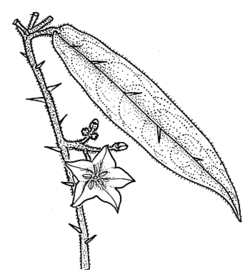Common name: Violet Nightshade
Solanum brownii Dunal APNI* Synonyms: Solanum violaceum R.Br. APNI*

Description: Erect shrub 0.6–1.8 m high, densely stellate-hairy; prickles sparse on branches and juvenile leaves, rarely on petioles and calyces, absent elsewhere.
Leaves narrow-ovate to elliptic, 6.5–13 cm long, 1.4–3 cm wide, margins entire or sinuate; upper surface dark green to grey-green and sparsely hairy, veins deeply inset and surface often "wrinkled"; lower surface yellowish to rusty, often woolly; petiole to 1.5 cm long. Juvenile leaves to 10 cm long and 3 cm wide, margins shallowly to deeply lobed.
Inflorescences 5–8-flowered; peduncle to 12 mm long; pedicels 13–18 mm long at anthesis. Calyx usually 6.5–10.5 mm long; lobes 2.5–5 mm long. Corolla broad-stellate to rotate, 22–35 mm diam., purple (rarely white).
Berry globular,18–29 mm diam., green to yellow-green.n Fruiting pedicels 12–18 mm long.
Flowering: Winter to Spring (June–October).
Distribution and occurrence: Mainly restricted to the Hunter Valley but with extensions north-west to Coonabarabran, south to the Blue Mountains and east to Dungog and Gloucester. Grows in eucalypt woodland or forest with a dense shrubby understorey; common after disturbance.
NSW subdivisions: NC, CC, SC, NT, CT, ST, NWS, CWS
Other Australian states: Qld Vic.
Text by Peter G. Wilson
Taxon concept: see Bean (2001)
APNI* Provides a link to the Australian Plant Name Index (hosted by the Australian National Botanic Gardens) for comprehensive bibliographic data
***The AVH map option provides a detailed interactive Australia wide distribution map drawn from collections held by all major Australian herbaria participating in the Australian Virtual Herbarium project.
|


